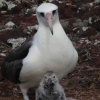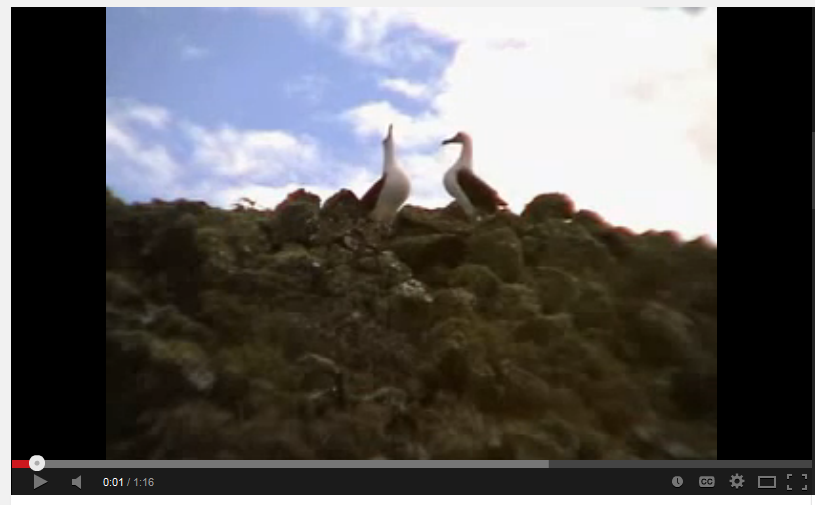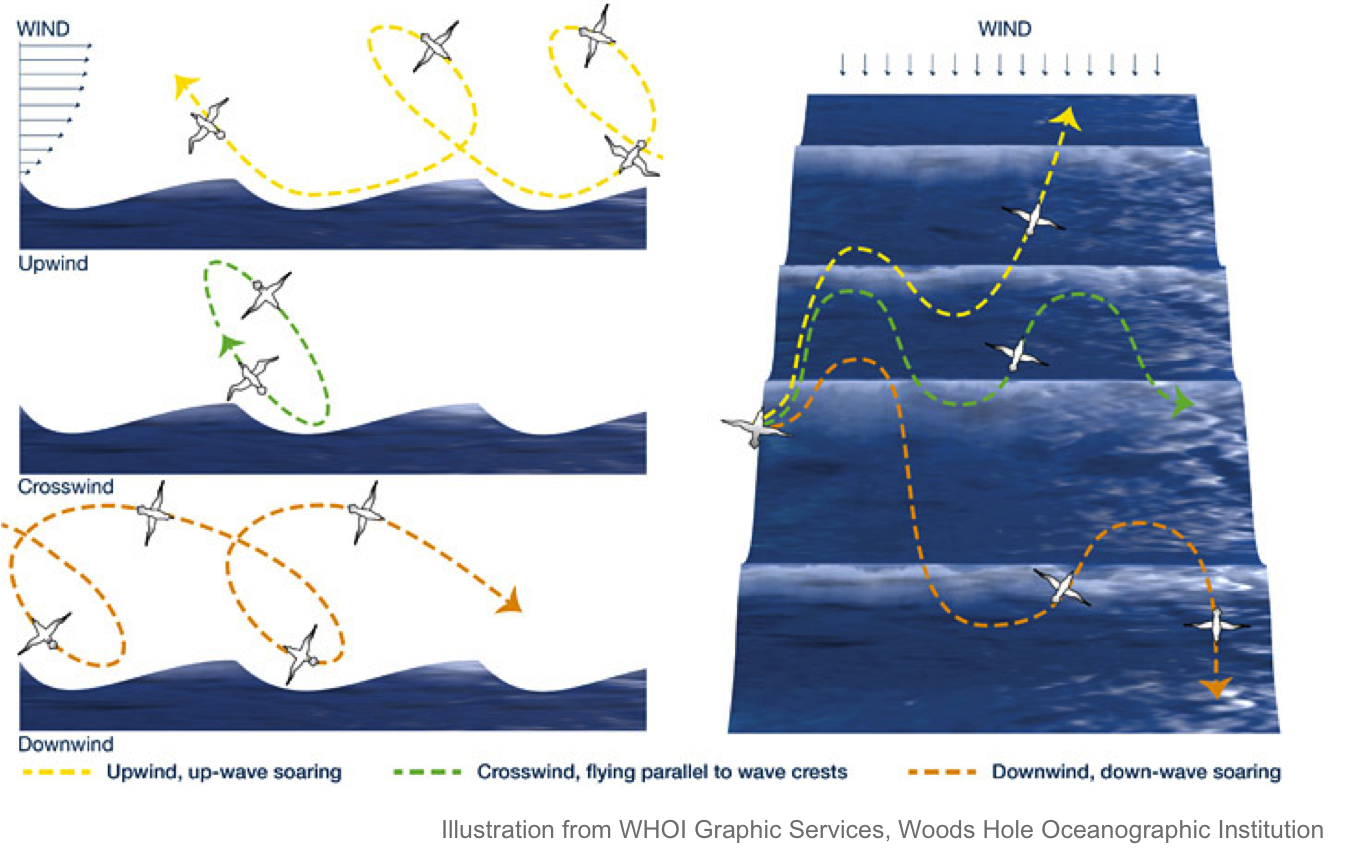Laysan Albatross
 Scientific Name: Phoebastria immutabilis
Scientific Name: Phoebastria immutabilis
Laysan albatross are seabirds, meaning they spend most of their lives at sea.
Albatross are the largest of the sea birds and one of the worlds most accomplished fliers.
Laysan albatross measure 32 inches high, and have a wingspan of up to almost 7 feet.
The following video footage explains some the characteristics of the Laysan Albatros and shows how a satellite transmitter is used to track the foraging behavior of the birds:
Feeding
- Laysan albatross mainly feed on squid and small fish in the surface of the ocean.
- Feeding primarily occurs at night when the prey of the albatross migrate to the surface of the ocean (seattleaudibon.org).
- Laysan albatross that breed on the Hawaiian islands undergo long-distance feeding migrations in the waters north of the islands.
Breeding
- Laysan albatross return to land to breed and raise their young. They do so in large, colonial groups.
- 99.7% of the population of Laysan albatross breed on the northern Hawaiian islands. Smaller breeding colonies occur on the Guadelupe Islands just west of the Mexican Baja Peninsula.
- Albatross are long-lived species, and don’t begin mating until they are 7 or 8 years old (seattleaudibon.org).
- During the first years of the albatross’s life, they form breeding pairs, which they will keep for life (www.wikipedia.org).
- To form mating pairs, laysan albatross undergo a ritualistic mating dance that can involve up to 25 different movements. Once the mating pair has been established, they will build their nest together (seattleaudibon.org).
- Once the female has laid their egg, both members of the mating pair incubate the egg until it hatches. The egg will hatch in about 9 weeks (seattleaudibon.org).
- Once the chick has hatched, the male and female will take turns undergoing feeding migrations north of the islands, returning to feed their chicks by regurgitating their stomach contents (seattleaudibon.org).
- Once the albatross is older than 8 years, it will breed annually until it is upwards of 40 years old (seattleaudibon.org)
Adaptations
- Dynamic soaring enables albatrosses to gain the energy required for flight from the wind. This involves repeated rising into wind and descending downwind to gain energy from the vertical wind gradient. This flight pattern enables albatross to travel up to 1,000 km without beating their wings (Wikipedia.com)
- Laysan albatross have large wing spans, ranging from 77-80 inches (~6.5-7 ft) to help with gliding.
- Albatross have an elbow lock system to keeps their wings open without the use of any muscles (no energy expenditure).
- Albatross have tubes running along the edges of their bills that allow them to measure the exact airspeed in flight. Taking these measurements gives them the information they need to perform the dynamic glide maneuver.
- Laysan albatross travel through predictable weather systems that enable them to use dynamic soaring techniques.
- Laysan albatross have waterproof plumage, preventing them from getting wet and cold.
Conservation
Threats
- Albatross and other seabirds are attracted to bait on longlines used to catch other species such as tunas and swordfish. Longlines are either placed on the surface of the ocean, or sunk to the ocean bottom to catch fish species that live in deeper water. Albatross are attracted to bait on these lines, and may become ensnared by hooks. Albatross may then be dragged to the ocean bottom as longlines are sunk, or are left trapped on the ocean’s surface where they may eventually die (www.seashepherd.org).
- Many seabird species, including albatross, are susceptible to ingestion of plastics in the ocean. Albatross feed on squid and fish eggs floating on the surface of the ocean, and may consume plastics thinking that they are food items. Studies have shown that plastic ingestion negatively impacts the health of seabirds, and may reduce their chances of survival (www.montereybayaquarium.org).
- Albatross breed on land, where adults and chicks are susceptible to predation by land animals. Invasive species such as rats and feral cats have been found to prey on Albatross and their young.
Conservation Measures
- Measures have been taken to reduce the unintentional catch of seabirds on longlines. These include attaching weights to longlines so that they sink more quickly, attaching streamers to lines so that they scare away birds, prohibiting longline fishing during periods of time when birds are foraging at sea, and banning the release of fisheries waste products, such as fish guts that attract seabirds while longlines are being set (www.seashepherd.org).
- In 2004, the Agreement on the Conservation of Albatrosses and Petrels was created, which legally binds countries to taking measures to reduce threats to Albatross. These include measures to reduce bycatch, protection of breeding colonies, and the control and removal of introduced species from breeding islands.
- Like sea turtles, knowledge of the foraging patterns of albatrosses has important conservation and management implications. Significant numbers of adult albatrosses are caught incidentally in long-line fishing. Albatrosses are long-lived, slow to mature, and raise only a single offspring each year. As a result, these birds are particularly sensitive to human impacts. Identification of the areas where albatrosses and long-line fisheries co-occur is critical for reducing mortality. A number of methods exist that are proven to reduce seabird bycatch in the long-line fleet with out hampering fishing efforts.
Tagging and Research
- Given their large size and global flight patterns, albatrosses have proven to be ideal for monitoring at-sea flight patterns using both satellite telemetry and archival tags.
- The logistics for deployment and recovery are simple as the birds aggregate by the thousands at breeding colonies and return regardless of reproductive status.
- Breeding adults make foraging trips on the order of a few days to several weeks. Non-breeding adults return to the island during the beginning of the mating season.
- For TOPP, efforts will be made to tag at breeding colonies in the Northern Hawaiian Islands as well as at Guadelupe Island. This will be the first attempt to tag birds in both locations.


